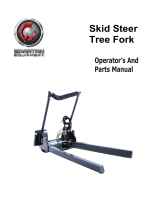
•Readallattachmentmanuals.
•Ensurethattheareaisclearofotherpeoplebefore
operatingthetractionunit.Stopthetractionunit
ifanyoneentersthearea.
•Neverleavearunningtractionunitunattended.
Alwayslowertheloaderarms,stoptheengine,set
theparkingbrake,andremovethekeybeforeleaving.
•Donotexceedtheratedoperatingcapacity,asthe
tractionunitmaybecomeunstablewhichmayresult
inlossofcontrol.
•Donotcarryaloadwiththearmsraised.Always
carryloadsclosetotheground.
•Donotover-loadtheattachmentandalwayskeep
theloadlevelwhenraisingtheloaderarms.Logs,
boards,andotheritemscouldrolldowntheloader
arms,injuringyou.
•Neverjerkthecontrols;useasteadymotion.
•Watchfortrafcwhenoperatingnearorcrossing
roadways.
•Donottouchpartswhichmaybehotfrom
operation.Allowthemtocoolbeforeattemptingto
maintain,adjust,orservice.
•Checkforoverheadclearances(i.e.branches,
doorways,electricalwires)beforedrivingunderany
objectsanddonotcontactthem.
•Ensurethatyouoperatethetractionunitinareas
wheretherearenoobstaclesincloseproximitytothe
operator.Failuretomaintainadequatedistancefrom
trees,walls,andotherbarriersmayresultininjury
asthetractionunitbacksupduringoperationifthe
operatorisnotattentivetothesurroundings.Only
operatetheunitinareaswherethereissufcient
clearancefortheoperatortosafelymaneuverthe
product.
•Beforedigging,havetheareamarkedfor
undergroundutilities,anddonotdiginmarkedareas.
•Locatethepinchpointareasmarkedonthetraction
unitandattachmentsandkeephandsandfeetaway
fromtheseareas.
•Beforeoperatingthetractionunitwithan
attachment,ensurethattheattachmentisproperly
installed.
SlopeOperation
Slopesareamajorfactorrelatedtoloss-of-controland
tip-overaccidents,whichcanresultinsevereinjuryor
death.Allslopesrequireextracaution.
•Donotoperatethetractionunitonhillsidesor
slopesexceedingtheanglesrecommendedinthe
StabilityDatasectionandthoseintheattachment
Operator’sManual.SeealsotheSlopeChart,page7.
•Operateupanddownslopeswiththeheavyend
ofthetractionunituphill.Weightdistribution
changes.Anemptybucketwillmaketherearof
thetractionunittheheavyend,andafullbucket
willmakethefrontofthetractionunittheheavy
end.Mostotherattachmentswillmakethefrontof
tractionunittheheavyend.
•Raisingtheloaderarmsonaslopewillaffectthe
stabilityofthemachine.Wheneverpossible,keepthe
loaderarmsintheloweredpositionwhenonslopes.
•Removinganattachmentonaslopewillmakethe
rearofthetractionunitheavy.RefertotheStability
Datasectiontodeterminewhethertheattachment
canbesafelyremovedontheslope.
•Removeobstaclessuchasrocks,treelimbs,etc.from
theworkarea.Watchforholes,ruts,orbumps,as
uneventerraincouldoverturnthetractionunit.Tall
grasscanhideobstacles.
•UseonlyToro-approvedattachments.Attachments
canchangethestabilityandtheoperating
characteristicsofthetractionunit.Warrantymaybe
voidedifusedwithunapprovedattachments.
•Keepallmovementsonslopesslowandgradual.Do
notmakesuddenchangesinspeedordirection.
•Avoidstartingorstoppingonaslope.Ifthetraction
unitlosestraction,proceedslowly,straightdownthe
slope.
•Avoidturningonslopes.Ifyoumustturn,turn
slowlyandkeeptheheavyendofthetractionunit
uphill.
•Donotoperateneardrop-offs,ditches,or
embankments.Thetractionunitcouldsuddenlyturn
overifatrackgoesovertheedgeofaclifforditch,
orifanedgecavesin.
•Donotoperateonwetgrass.Reducedtractioncould
causesliding.
•Donotparkthetractionunitonahillsideorslope
withoutloweringtheattachmenttotheground,
settingtheparkingbrake,andchockingthetracks.
MaintenanceandStorage
•Disengagetheauxiliaryhydraulics,lowerthe
attachment,settheparkingbrake,stoptheengine,
andremovethekey.Waitforallmovementtostop
beforeadjusting,cleaning,orrepairing.
•Cleandebrisfromattachments,drives,mufers,and
enginetohelppreventres.Cleanupoilorfuel
spillage.
5























